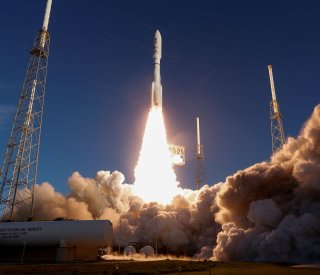How America Will Be Able to Defend Itself in Space from Russia and China
The U.S. Air Force is taking fast new steps to rev up for warfare beyond the Earth’s atmosphere by networking satellites and prototyping innovative new weapons for use in space, due in large measure to rapid Chinese and Russian advances.
The U.S. Air Force is taking fast new steps to rev up for warfare beyond the Earth’s atmosphere by networking satellites and prototyping innovative new weapons for use in space, due in large measure to rapid Chinese and Russian advances.
“Almost all of our military capabilities depend upon space capabilities, and our adversaries are weaponizing space,” Lieutenant General JT Thompson, Commander, Space and Missile Center, told The Mitchell Institute in a video series.
Space war technology increasingly involves a wide span of sensors and weapons systems, including satellite-mounted missiles or lasers, cyber hardening, electronic warfare (EW) applications and defenses against anti-satellite weapons (ASAT).
These are areas, Thompson explained, where China continues to make fast progress.
“China’s strategic support force with their EW and cyber force has begun training specialized units with ASAT weapons,” he said.
The U.S. strategy, in response, is multifaceted, including ASAT defenses, new missile defense systems, new infrared missile warning sensors, space-based offensive weapons and even the possibility of some kind of space drone.
Of greatest significance, and very close to being a possibility, is the Pentagon effort to network satellites to one another and launch additional smaller, agile, and faster lower-altitude sensors. Moreover, the sensors built into satellites themselves will increasingly perform more independent command and control functions, in some instances helping to discern the difference between an actual ICBM or nearby decoys intended to thwart and confuse defenses. Most seekers at the moment often rely upon missile-integrated sensors tasked with guiding various anti-missile weapons called “Kill Vehicles.”
“Gone are the days of every satellite having to have its own unique ground control segment. We have fueled innovation with rapid prototyping and have been making schedule and delivery a key performance parameter,” Thompson explained.
Networking satellites to one another through hardened connections with both ground terminals and other space-operating satellites can enable U.S. Commanders to establish a more accurate, continuous track on approaching weapons traveling through space. Instead of tracking or handing off threat data from one field of view to another in a separated or stovepiped fashion, meshed networks of satellites can massively improve sensor-to-shooter time for human decision-makers.
There are several interesting technical elements here, such as current initiatives to integrate ground terminals successfully to each other through large-scale cloud migration with various kinds of hardened transmission systems.
One element of this includes U.S. efforts to construct and add large constellations of Very Low Earth Orbit Satellites (vLEOs). These assets can move quickly, operate closer to the Earth, and quickly connect data while in space, all while closely tracking ground activity. Not only does this naturally improve space warfighting operations, but it also furthers the Air Force’s “redundancy” strategy, meaning a larger, more dispersed collection of satellites can ensure operations continue in the event that one is destroyed or disabled.
China is also quickly adding new satellites to space, as evidenced by the recent launch of an upgraded Long March 11A system, described in a May report from China’s Online People’s Daily.
“The Long March 11A will be able to send 1.5 tons of payload to a sun-synchronous orbit at an altitude of 700 kilometers, nearly four times the Long March 11s capacity,” the paper says.
The larger payload will allow a wider range of sensors, cameras, long-range data link signals, and possibly even function as a weapons detection or delivery system.
“Two satellites carried by a Long March-2D carrier rocket were launched from the Jiuquan Satellite Launch Center, Northwest China’s Gansu province, May 31, 2020,” the report said.
Kris Osborn is defense editor for the National Interest. Osborn previously served at the Pentagon as a Highly Qualified Expert with the Office of the Assistant Secretary of the Army—Acquisition, Logistics & Technology. Osborn has also worked as an anchor and on-air military specialist at national TV networks. He has appeared as a guest military expert on Fox News, MSNBC, The Military Channel, and The History Channel. He also has a Masters Degree in Comparative Literature from Columbia University.
Image: Reuters

